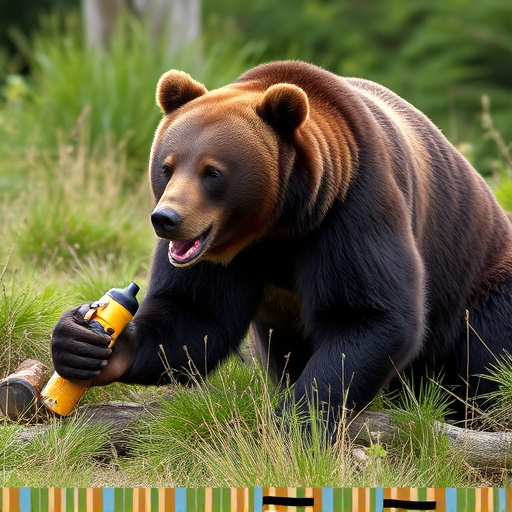Bear spray is a specialized pepper spray effective against black and grizzly bears within 20-30 feet (6-9 meters), temporarily blinding and irritating them. Its effectiveness depends on wind conditions, terrain, bear size, spray type, and application technique. The best strategy is to maintain a safe distance of at least 25 feet (7.6 meters) and use the spray directly into the bear's face and eyes if closer, aiming for its eyes with loud noises to deter an aggressive charge. Staying within the optimal range and understanding usage techniques are crucial for ensuring safety during encounters with charging bears.
“Bear spray has long been touted as a crucial tool for self-defense against charging bears, but its effectiveness is not universally understood. This article delves into the science behind bear spray, exploring how it works and its limitations. We analyze factors that influence its effective distance, providing best practices for emergency usage. Through real-world scenarios, we evaluate the spray’s performance at various distances to determine the optimal use cases for this popular bear deterrent, focusing on maximizing the best distance for bear spray effectiveness.”
- Understanding Bear Spray: How It Works and Its Limitations
- Factors Affecting the Effective Distance of Bear Spray
- Best Practices for Using Bear Spray in Emergencies
- Real-World Scenarios: Evaluating Bear Spray Effectiveness at Different Distances
Understanding Bear Spray: How It Works and Its Limitations
Bear spray, also known as bear repellent, is a specialized pepper spray designed to deter aggressive bears when used correctly. It works by causing temporary blindness and extreme irritation in the eyes, nose, and respiratory system of the target bear. The primary active ingredient, capsaicin, is derived from chili peppers and is highly effective against both black and grizzly bears.
While bear spray can be a crucial tool for safety in bear country, understanding its limitations is essential. The best distance for bear spray effectiveness varies based on several factors, including wind conditions, terrain, and the size of the bear. Typically, it’s most effective from a range of 20 to 30 feet (6 to 9 meters). However, in windy conditions, the spray can dissipate more quickly, reducing its impact. Moreover, bears may not react immediately, giving them time to charge despite the spray. Therefore, it’s crucial to follow proper usage instructions and have a backup plan for encounters within the bear’s effective range.
Factors Affecting the Effective Distance of Bear Spray
The effectiveness of bear spray depends on several factors, including the type of spray used, environmental conditions, and the distance between you and the charging bear. The best distance for bear spray effectiveness typically ranges from 20 to 30 feet (6 to 9 meters). However, this can vary significantly based on the sprayer’s design and the specific circumstances.
For instance, factors like wind speed and direction can carry the spray beyond the optimal range, reducing its impact. Additionally, the angle at which the spray is directed and the bear’s behavior—such as whether it’s running directly at you or turning to avoid the spray—can also influence how well the spray works. It’s crucial to understand these variables to ensure maximum protection when encountering bears in the wild.
Best Practices for Using Bear Spray in Emergencies
When faced with an emergency encounter while hiking or camping in bear country, knowing how to effectively use bear spray is crucial. The best practice involves maintaining a safe distance and using the spray only as a last resort. It’s recommended to stay at least 25 feet (7.6 meters) away from a bear before considering spraying. This distance ensures your safety while allowing the spray to reach the bear, temporarily deterring its charge.
Upon encountering a bear, make yourself appear larger by raising your arms or opening your jacket. Speak firmly and loudly to convey that you are not prey. If the bear continues to advance, activate the spray into the bear’s face and eyes. Aim for direct eye contact and try to keep the spray can as close to the bear as possible while maintaining a safe distance. The ideal time to deploy bear spray is when the bear is within 20-30 feet (6-9 meters), allowing for maximum effectiveness without increasing your risk of injury.
Real-World Scenarios: Evaluating Bear Spray Effectiveness at Different Distances
In real-world scenarios, bear spray has proven its effectiveness in deterring charging bears at various distances. The best distance for bear spray effectiveness is generally considered to be within 20 to 30 feet (approximately 6 to 9 meters). At this range, the spray can cover the bear’s face and eyes, temporarily blinding and disorienting it, giving you precious time to escape or defend yourself.
However, it’s crucial to note that the effectiveness diminishes significantly beyond this optimal range. Wind conditions, spray direction, and the bear’s behavior all play a role in how well the spray performs. In dense forest settings, for instance, the spray might not reach the bear due to obstructions, while in open areas, wind could blow the spray away from its target before it has a chance to take effect. Therefore, understanding the best distance and practicing proper usage techniques are vital for ensuring safety in encounters with charging bears.
In conclusion, bear spray has proven to be an effective deterrent against charging bears when used correctly. Understanding its mechanisms, the factors influencing its range, and adopting best practices can significantly enhance safety in bear country. Knowing the optimal distance for bear spray effectiveness—typically around 20-30 feet (6-9 meters)—is crucial. However, real-world scenarios show that proximity plays a significant role, emphasizing the need for awareness and preparation when encountering bears. By combining knowledge of bear behavior with the responsible use of bear spray, individuals can better protect themselves in these wild environments.
